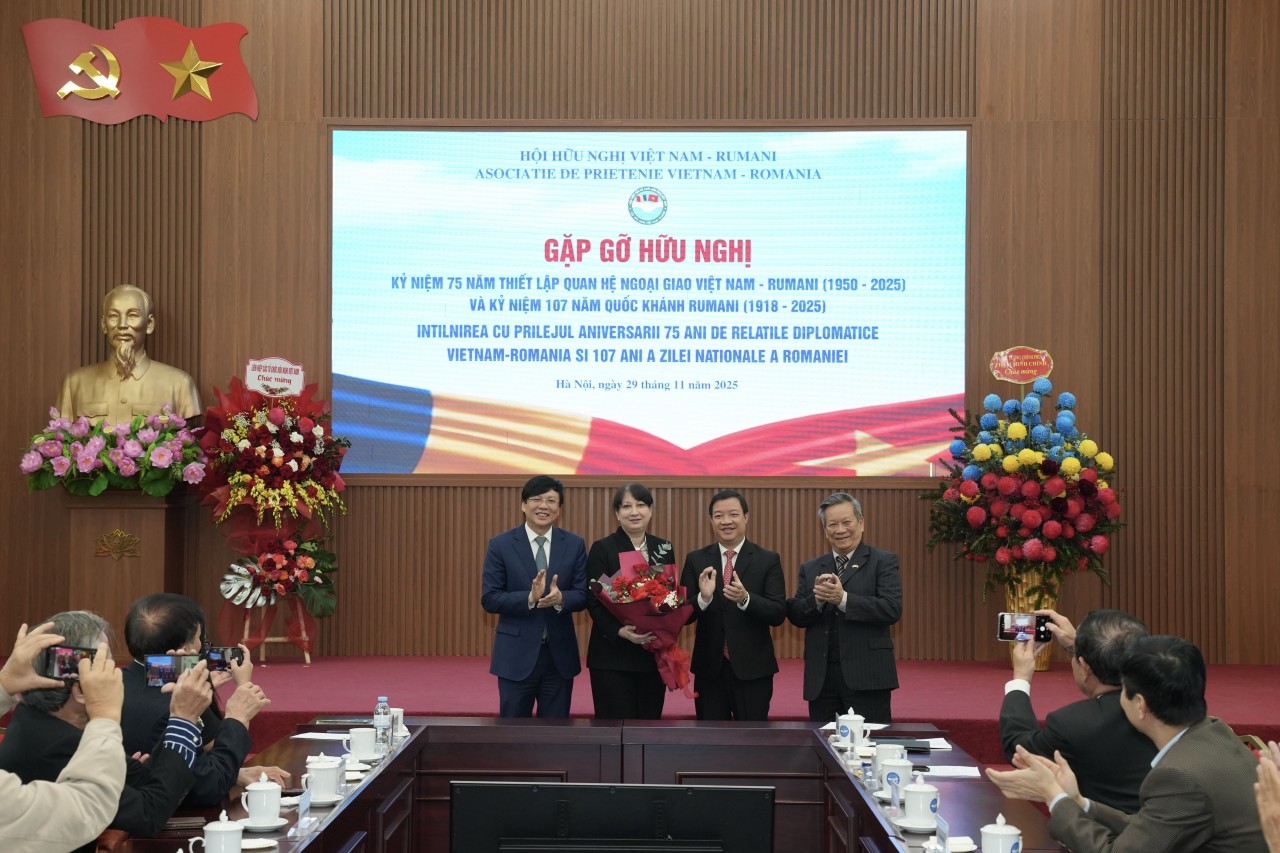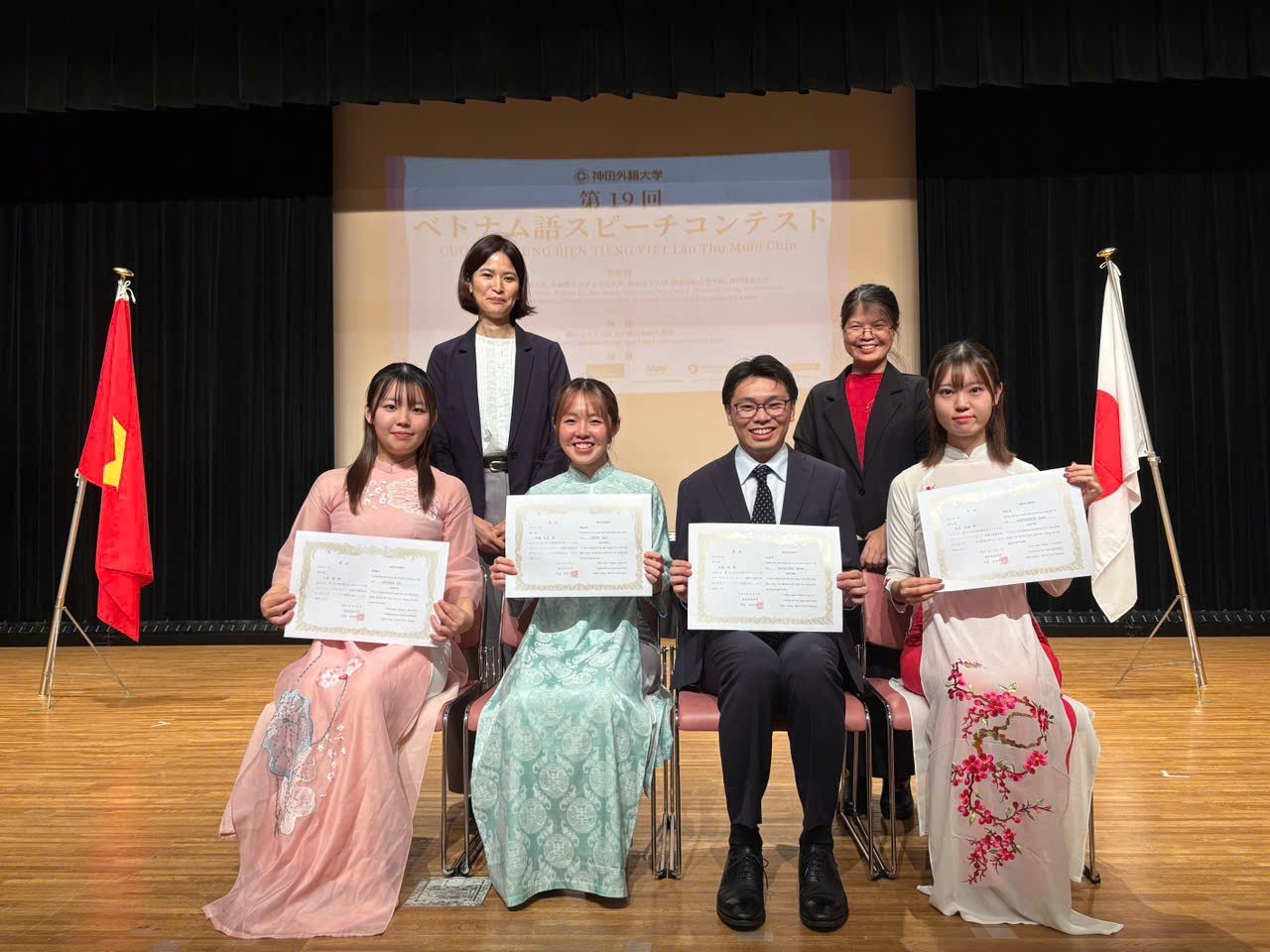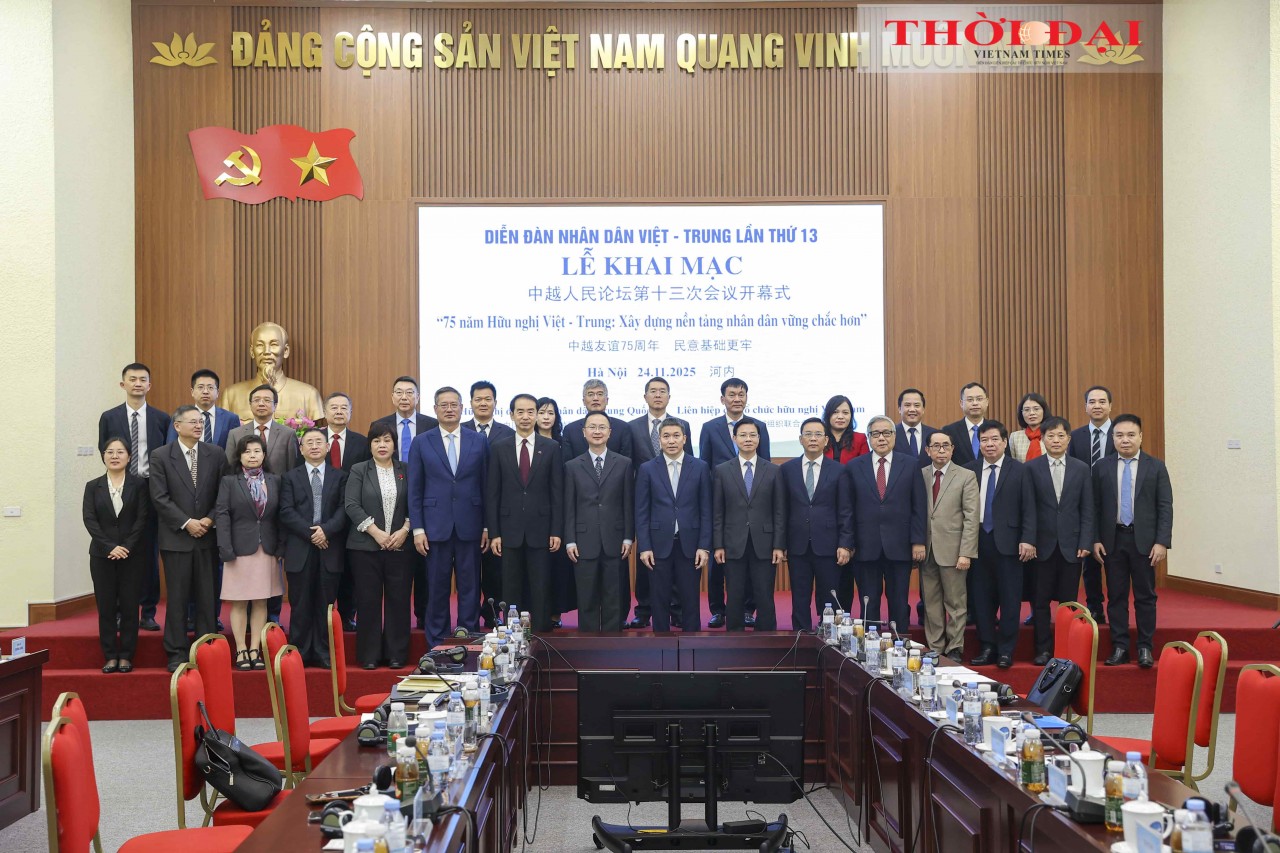Practical experience in cultural diplomacy
I experienced three terms working abroad, witnessed and also contributed my small part to strengthening friendly relations and cooperation with partner countries, contributing to fulfilling the political tasks of the country in different periods.
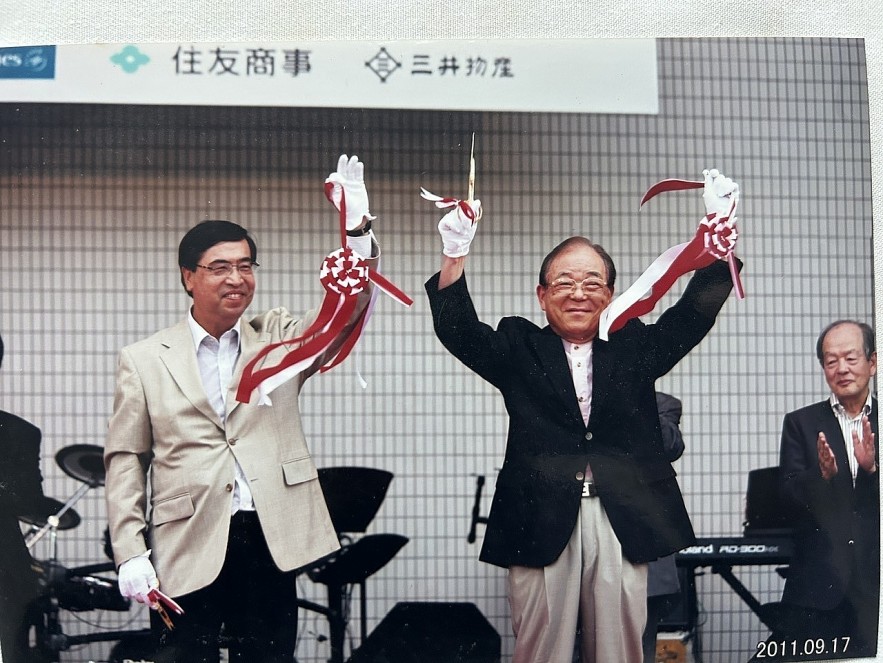 |
| Ambassador Nguyen Phu Binh and Member of Diet for Japan Matsuda Iwao, co-chairs of the Viet Nam Festival in Japan 2011 at the gathering before the festival. Photo: Phu Binh |
From 1973 to 1977, I worked at the Embassy of Viet Nam in the Democratic People Republic of Korea (DPRK). At that time, the resistance war against the United States for national salvation was entering its decisive phase. In the DPRK, there were the Embassy of the Democratic Republic of Viet Nam and the Embassy of the Provisional Revolutionary Government of South Viet Nam. In name, these were two separate diplomatic missions. But internally, we followed the policy of the Party, operating independently but coordinating closely with each other. One of the coordinated activities of the two embassies was to mobilize the Korean people to support the resistance war against the United States for national salvation. At that time, the Party, Government and people of the DPRK strongly supported our cause, but what I felt most clearly was the vibrant atmosphere during performances by art troupes from home, especially the performances of the Liberation Art Troupe in its world tour, which created a strong resonance among the Korean people. The music and dance performances reflected the courageous and heroic struggle of our people, both in the south and the north, while expressing the national characteristics and revolutionary optimism of our people. I remember clearly that the Liberation Art Troupe came to perform in the DPRK in 1974 and only one year later, our people won complete victory, and in the following year, 1976, our people completed national reunification. I was honored to serve the national art troupe of the unified Viet Nam when it performed in the DPRK that year. Among the performances, I will never forget “The Song of Reunification” through the tender, sweet voice of singer Thu Hien, now a People Artist, expressing the emotion of North and South reunited, bringing immense pride to us Vietnamese living far from home but whose hearts always remained tied to the homeland.
At the end of 1992, I was appointed by the Party and State as the first Ambassador to the Republic of Korea after the two countries agreed to establish diplomatic relations. During more than four years in Korea (ending in early 1997), I had many memories with a country that once stood on the opposite side during our long resistance war, but due to developments in world affairs, the policies of both countries and the interests of both peoples, gradually became a friendly and important partner of ours in the region and internationally. However, a crucial factor creating mutual understanding and close relations between the two countries is the similarity in history and culture, and the early beginning of people-to-people exchanges.
Just a few months after arriving in Seoul, I received a special delegation, the Ly Hoa Son clan, descendants of Ly Thai To and Prince Ly Long Tuong, who had to leave the country and go to Goryeo when the Tran dynasty replaced the Ly dynasty nine centuries earlier. Although fully integrated into Korean society, this clan still affirmed their Vietnamese origin. This is perhaps the earliest and longest surviving overseas Vietnamese community in history.
Only nine months after we opened the embassy in Seoul, we participated in a major international economic event, the Daejeon Expo 1993, held in a central province of Korea. The organizers invited us to hold Viet Nam Day on our National Day at the Expo. At that time, a Korean travel company brought the Bong Sen art troupe from Ho Chi Minh City to perform in Korea. We proposed that the organizers invite this art troupe to perform at the opening ceremony. To our surprise, when arriving at the scene, many Korean visitors at the Expo were wearing Viet Nam conical hats. Korean companies, seeing public interest in Viet Nam following the establishment of diplomatic relations after 17 years of interruption, purchased Viet Nam conical hats to sell at the Expo. Koreans considered Viet Nam presence at the Expo (the embassy, delegation, Vietnamese enterprises, Bong Sen art troupe, Viet Nam products) as a special event. On Viet Nam National Day, the day after the opening, at the outdoor performance stage in the Expo area, with thousands of seats, the audience was so crowded that no seats were left, many wearing Viet Nam conical hats. The performances by the Bong Sen Art Troupe, featuring singers Hong Nhung, Thanh Lam, and traditional instrumentalists, were enthusiastically welcomed by the Korean public. When the performance ended, many Koreans stayed, asking to take photos with the Vietnamese artists, especially female artists in ao dai. Along with performances conveying messages of peace, cooperation and friendship, the conical hat and the ao dai became symbolic images of the first Viet Nam Day event in Korea.
Although the two countries had just established diplomatic relations, the relationship in all fields developed rapidly: frequent high-level exchanges, strong increases in Korean investment and business in Viet Nam, regular cultural and artistic exchanges, performances and fashion shows in both countries. Korean television dramas aired regularly on Vietnamese television and became popular. Korean broadcasters sent many crews to make documentaries about Viet Nam and feature films about bilateral relations. Vietnamese artists performing in Korea appeared frequently in Korean media. When Vietnamese artists visited Korea, our embassy often hosted cultural activities and invited Korean audiences, the diplomatic corps and ASEAN countries. At the grand reception celebrating the 50th National Day of Viet Nam (1995) in Seoul, we invited a Vietnamese art troupe to perform, making the event vibrant and impressive. Vietnamese artists in graceful ao dai were prominently featured in Korean media.
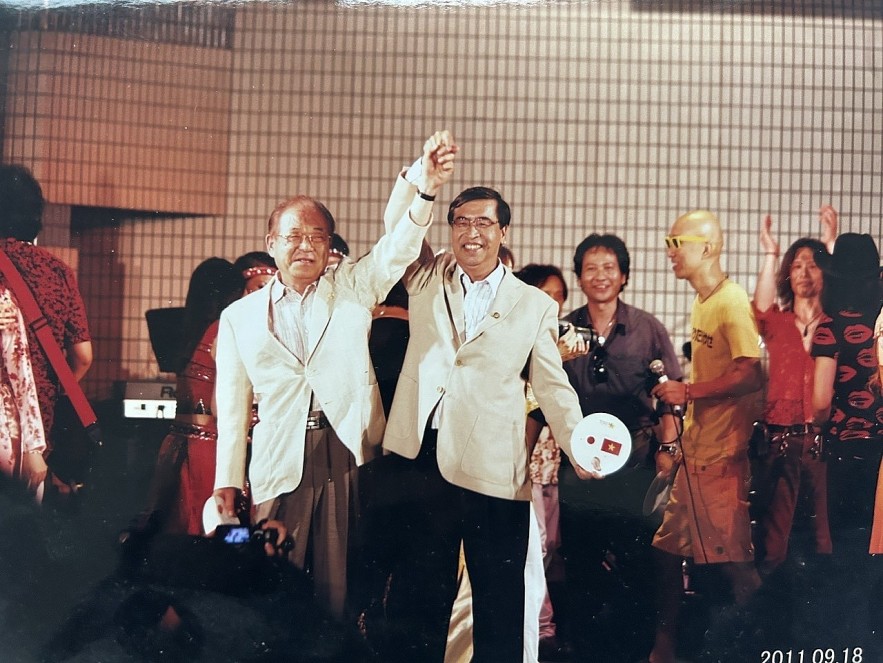 |
| Ambassador Nguyen Phu Binh and Diet member Matsuda Iwao at the opening ceremony of the Viet Nam Festival in Japan 2011. (Photo: Phu Binh) |
Viet Nam Festival in Japan: Viet Nam culture spreads to the host country
I began my term as Ambassador to Japan in early 2008 and cultural and people-to-people factors appeared even before the start of my new term. In late November 2007, as Deputy Minister of Foreign Affairs in charge of Northeast Asia, I accompanied President Nguyen Minh Triet on a visit to Japan. In the audience with Emperor Akihito, the Emperor said the relations between the two countries date back to the eighth century, when Buddhist monk Phat Triet from the Lam Ap region (now Nghe Tinh area) of the Champa kingdom went to practice at Todaiji Temple in Nara (the capital of Japan at that time). Phat Triet brought with him musical melodies from Lam Ap and Cham court dances, which deeply influenced traditional Japanese court music. The Emperor affirmed that wet rice cultivation and poultry raising were also introduced to Japan by Phat Triet.
At the end of the visit, President Nguyen Minh Triet witnessed the signing of an agreement between Ambassador Chu Tuan Cap of Viet Nam and Member of Diet for Japan Matsuda Iwao, Vice President of the Japan-Viet Nam Parliamentary Friendship Alliance, on co-organizing the first Viet Nam Festival in Japan in 2008 to celebrate the 35th anniversary of diplomatic relations. I understood that only a few months later, as the new Ambassador to Japan, I and the staff of the Embassy of Viet Nam would have to implement that task. However, in early 2008, I received instructions from the Ministry of Foreign Affairs that due to the global financial crisis and rising public debt, the Ministry could not provide budget for the embassy to organize the Viet Nam Festival in September 2008 as planned. I was very concerned because missing the anniversary timing would reduce the meaning of the event. Especially, an agreement signed before the President would lose significance if not implemented.
After discussing with Matsuda and Japanese colleagues on the organizing committee, they believed that although the Viet Nam Festival was led by Viet Nam, Japan would actively participate at the highest level. They suggested that based on the initial contribution from our side to the committee account, they would mobilize Japanese companies doing business with Viet Nam to sponsor. Moreover, the festival venue, Yoyogi Park, was spacious; if we could attract many enterprises from both countries to rent booths and food stalls, after deducting venue costs, the remaining funds would be sufficient. At that time, I met Ho Huy, Chairman and General Director of Mai Linh Group, who had joined the business delegation during President Nguyen Minh Triet visit the previous year. Hearing our difficulties and the Japanese suggestions, Ho Huy offered to contribute immediately a substantial amount and proposed several Vietnamese companies successfully doing business with Japan for fundraising. Everything unfolded as predicted. Preparations went smoothly. The festival took place over the last weekend of September 2008. On Friday evening before the festival, the organizing committee gathered with members of the Japan Viet Nam Parliamentary Friendship Alliance, the Foreign Minister and senior politicians, embassy staff and delegates from home, businesspeople and artists. On Saturday morning, we were honored to welcome Crown Prince Naruhito, now the Emperor of Japan, to the opening ceremony along with many top Japanese politicians. This was the first time the Crown Prince attended an outdoor festival of a foreign country.
For two full days, the performance stage was always packed. Singers My Linh, Lam Truong, Hien Thuc, and traditional musician Hai Phuong performed three shows a day, exhausted but happy with the enthusiastic audience. Dozens of booths selling souvenirs and Vietnamese and Japanese food were overflowing. On Sunday afternoon, heavy rain fell, yet the audience stayed, and the closing ceremony remained full.
Before the festival, we planned to organize it every five years. But at the closing moment, seeing the enthusiastic response, Matsuda and I decided to announce that the Viet Nam Festival would be held every two years, and the audience cheered. The next day, the park management informed us that the first Viet Nam Festival attracted more than 180,000 visitors. A surprising number, although we knew it was huge.
A few months later, in early 2009, Matsuda suggested making the festival an annual event. The park management also prioritized scheduling festival weekends near the diplomatic anniversary date and reduced venue fees. Japanese organizers believed that Japanese families tended to spend weekends together at big events; if the festival invited famous artists and offered delicious food stalls, attendance and spending would sustain the event financially.
Matsuda proposal convinced us. To date, we have organized 18 Viet Nam Festivals annually at Yoyogi Park in Tokyo. Festivals are also held in Kanazawa, Osaka, and Fukuoka with local Japanese authorities. In localities with many Vietnamese residents such as Saitama, local Viet Nam associations also organize their own festivals with diverse formats.
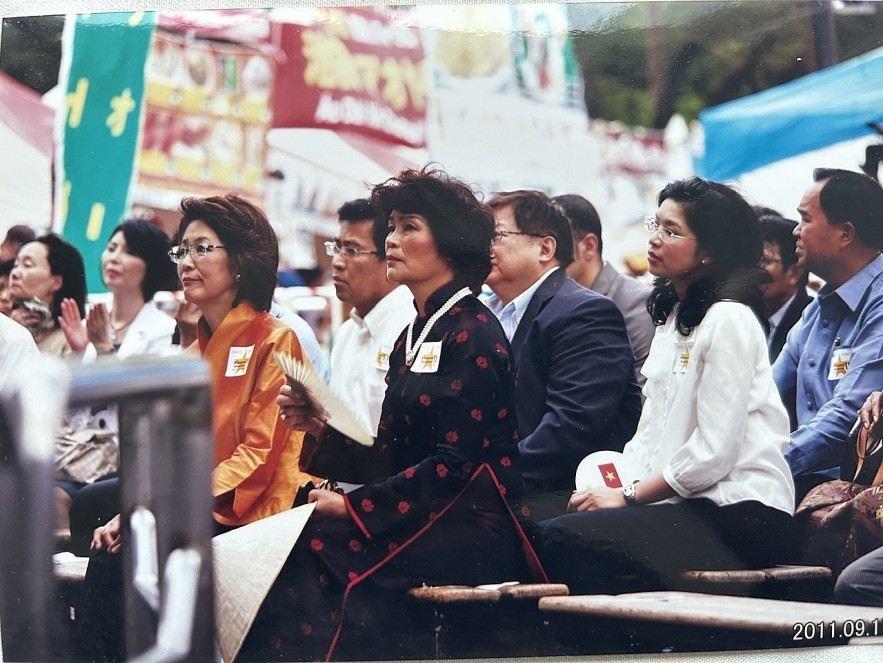 |
| Ambassadors and spouses of ASEAN countries attending the Viet Nam Festival in Japan 2011. (Photo: Phu Binh) |
Another cultural activity is that Viet Nam often sends feature films to Japanese film festivals and frequently wins major awards, especially films by director Dang Nhat Minh such as “When the tenth month comes” and “Do not burn.” Viet Nam music, especially songs by Trinh Cong Son, is widely popular in Japan. Today, the Viet Nam Symphony Orchestra under conductor Honna Tetsuji is also a bridge between the two music cultures.
In Japan, besides Nara where monk Phat Triet came to practice in the eighth century, there are other localities imbued with the long standing tradition of relations between the peoples of the two countries. For example, in Nagasaki, the westernmost province of Japan, there is a joint tomb of merchant Araki Sotaro and Princess Ngoc Hoa, which is evidence of the deep Viet Nam Japan love story from about 400 years ago when Japanese merchant ships often came to Hoi An and Pho Hien for trade. Today, in Nagasaki, the Princess Procession Festival is still held, reenacting the scene of local people enthusiastically welcoming Princess Ngoc Hoa, daughter of Lord Nguyen Phuc Nguyen, to her husband home. This inspired Ambassador Yamada Takio to propose that artists of the two countries create the musical Princess Anio, which was widely performed in both countries to mark the fiftieth anniversary of diplomatic relations in 2023. In Shizuoka province, southwest of Tokyo, many traces remain from the period when Phan Boi Chau was in Japan to carry out the Dong Du movement. In Asaba town, there is still a large stele engraved with words of gratitude to doctor Asaba for wholeheartedly helping Vietnamese youths in the Dong Du movement. Today, many exchange and cooperation activities are taking place between Asaba town in Shizuoka province and Phan Boi Chau homeland in Nghe An as well as the city of Hue to honor the bonds between the peoples of the two countries from more than a century ago.
The Vietnam-Japan Friendship Association and cultural bridges
After 50 years of diplomatic relations, Vietnam-Japan relations are at their peak. Japan has become one of Viet Nam most important and reliable partners. This creates favorable conditions for the activities of the Vietnam-Japan Friendship Association.
As a mass organization promoting friendship with Japan, the Vietnam-Japan Friendship Association has made great efforts to maintain and develop relations with friendship organizations in Japan, both national and local. The association also supports Vietnamese localities in seeking cooperation and assistance from Japanese friendship organizations, coordinating cultural and people-to-people exchange activities in localities.
The association and its local chapters have cooperated with Japanese organizations to successfully organize Japan Festivals in Ha Noi, Ho Chi Minh City, Ha Long, Da Nang, Hue and many other places. The association also actively participates in Viet Nam Festivals and cultural exchanges in Tokyo and other Japanese localities.
Member organizations of the association, notably the Viet Nam Association of Japan Alumni (VAJA), operate effectively and contribute to bilateral cooperation in all fields. As an active member of the ASEAN Council of Japan Alumni (ASCOJA), VAJA also contributes to cooperation and friendship between Southeast Asian countries and Japan.
Opportunities, challenges and solutions to strengthen cultural diplomacy
The organization of cultural exchange and people-to-people exchange activities is one of the main functions of the Viet Nam Japan Friendship Association, but there are major obstacles that have prevented the association from carrying out many such activities both in Viet Nam and in Japan. The biggest difficulty is limited funding, while the demand for these activities is very high. Although the association frequently receives delegations from Japanese friendship organizations with Viet Nam, both at the national level and the local level, the organization of receptions or friendly meals and the giving of gifts requires a certain budget, so the association can only select a few truly important delegations to use its funding. The association leadership of cultural and people-to-people exchanges in Viet Nam is mainly nominal. Organizing delegations of the association to visit Japan is also kept to a minimum because the cost for delegations abroad is quite high; participation in activities in Japan is also mostly nominal.
The association leadership has also been passive, not fully taking advantage of favorable conditions to expand activities. Agencies with similar tasks still work separately without effective coordination to mobilize resources for shared goals.
In the context of strong Vietnam-Japan relations, many favorable conditions arise. Japan is a leading economic partner of Viet Nam, with more than 20,000 Japanese living in Viet Nam due to expanding investment. Meanwhile, the Vietnamese community in Japan has exceeded 600,000 people, becoming the second largest foreign community in the country and the second largest Vietnamese community abroad after the United States. Therefore, beyond normal bilateral cultural exchange, the cultural needs of both communities have increased significantly.
Japanese enterprises operating in Viet Nam actively support cultural promotion and people-to-people exchange. Cooperation between the Vietnam-Japan Friendship Association and Japanese partners faces no major obstacles.
In the past, Vietnamese in Japan were mainly wartime scholars, graduates working in companies, students and contract workers, none of whom had strong financial resources. Therefore, the community needed cultural activities but lacked means, relying mainly on the embassy.
The situation of the Vietnamese community in Japan, however, has completely changed. From about 30,000 people fifteen years ago, the number has now reached 600,000 with a diverse composition. In addition to workers and students, a growing group of entrepreneurs, restaurant owners and service shop owners are running vibrant and effective businesses. While in the past Vietnamese lived mainly in cities and industrial zones, they are now present in all 47 prefectures across Japan. From a passive role, mainly relying on activities organized by our representative missions and domestic organizations, the leaders of community organizations together with Vietnamese enterprises operating in Japan or cooperating with Japanese partners now actively coordinate with our representative missions in organizing festivals or cultural and people to people exchange activities. In several localities under the jurisdiction of our missions, the local Vietnamese associations proactively request permission and cooperate with local authorities to organize such activities.
In Viet Nam, there are an increasing number of agencies and organizations with the function and responsibility to promote cultural exchange and people-to-people exchange activities with foreign countries, including Japan. In addition to the Viet Nam Union of Friendship Organizations and the Viet Nam Japan Friendship Association, within the Ministry of Foreign Affairs the Northeast Asia Department and the Department of Foreign Affairs Service and Cultural Diplomacy are also responsible for this work. The State Committee for Overseas Vietnamese under the Ministry of Foreign Affairs is also responsible for caring for the Vietnamese community overseas, including in Japan. In particular, the Ministry of Culture, Sports and Tourism has been very active in promoting cultural activities abroad, especially at major international events. Localities that have cooperative relations with Japanese prefectures, as well as enterprises that are cooperating and doing business with Japanese partners, also pay great attention to cultural and people-to-people exchange and are ready to participate in cultural exchange events held in both countries. Notably, in recent years, large-scale performances by groups of artists combining music with various other art forms and using advanced technology have attracted tens of thousands of spectators each night, creating a new trend and a new economic sector known as the cultural industry. In the context of deep international integration today, along with the successful performances of Vietnamese artists abroad, bringing the Vietnamese cultural industry overseas is becoming a major trend, contributing effectively to promoting Vietnamese culture, the country and the people of Viet Nam to the world in a new era of development. This is a new opportunity that the Viet Nam Japan Friendship Association needs to grasp in order to fulfill its functions and tasks.
To uphold its role in cultural diplomacy and people-to-people exchange with Japan, the association may focus on several strategic directions.
First, Japan is a top important partner of Viet Nam, and the friendship organizations with Viet Nam that support Viet Nam are very diverse, including nationwide organizations as well as local ones, all of which have traditional relations with the Viet Nam Japan Friendship Association. These organizations carry out many rich and diverse activities in localities of Viet Nam and frequently visit Viet Nam. With the role of a focal organization managing the relations of these organizations with their Viet Nam partners and receiving delegations when they visit Viet Nam, the Association should propose to the competent authorities to increase the budget allocated to it. It is necessary to standardize proposals for gifts for the leaders and members of the delegations of Japanese friendship organizations visiting Viet Nam and to plan the budget for delegations of the Association visiting Japan according to specific annual needs.
Second, it is necessary to proactively promote the establishment of a coordination mechanism for cultural diplomacy and people to people diplomacy activities among agencies that share the responsibility of developing cultural relations with Japan, such as the Ministry of Foreign Affairs (Northeast Asia Department, Department of Foreign Affairs Service and Cultural Diplomacy, State Committee for Overseas Vietnamese), the Ministry of Culture, Sports and Tourism, and the Viet Nam Union of Friendship Organizations, the Viet Nam Japan Friendship Association, in order to unify policies and measures to strengthen cultural diplomacy and people to people exchange with Japan every year. For important, large-scale activities, a joint organizing committee including the above components should be established.
Third, in addition to the state budget (if any), attention should be paid to encouraging and exploiting contributions and sponsorships from businesses of the two countries that are cooperating, enterprises within the Vietnamese community in Japan, organizing exhibitions and trade activities, and facilitating participation of businesses from both countries and the Vietnamese community, generating profits from activities during the events.
If there are policies and coordinated measures as above, we will be able to effectively carry out the leading role in cultural diplomacy and people-to-people exchange with Japan.
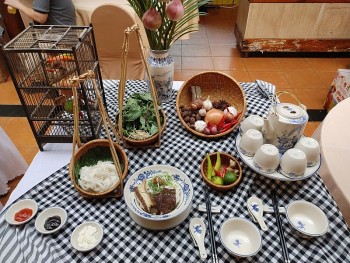 | “Vietnam Pho Festival 2025” Kicks Off in Singapore On October 18, the Vietnam Pho Festival 2025 officially kicked off at Our Tampines Hub in Singapore, attracting a large number of visitors eager to ... |
 | Newly-launched Project Enhances Sustainable Agricultural Production Capacity for 10,000 Women Women are often confined to caregiving roles and are rarely recognized or included in decisions related to production and consumption. They also face significant barriers ... |







